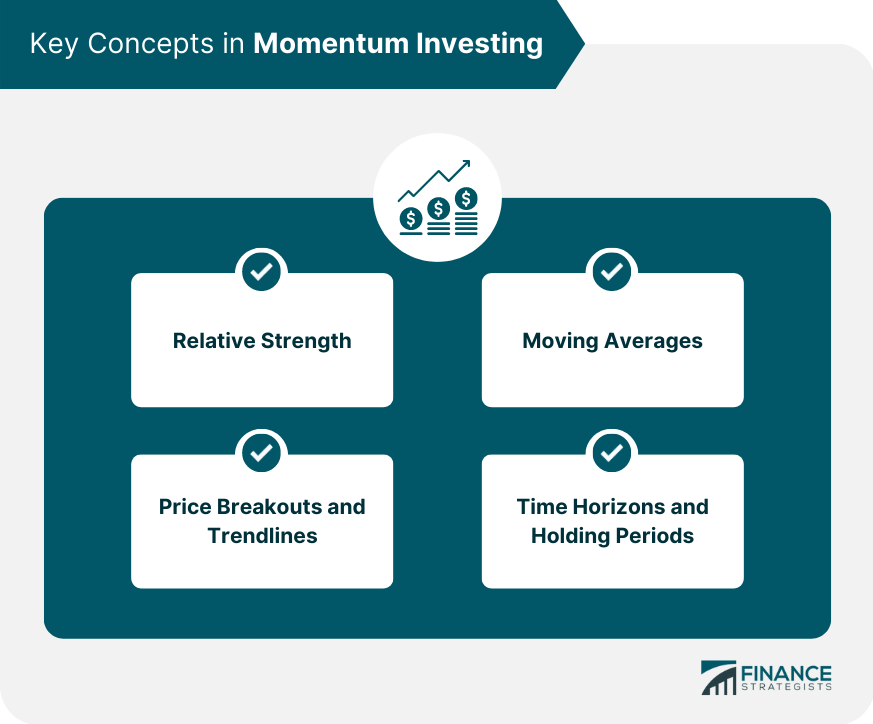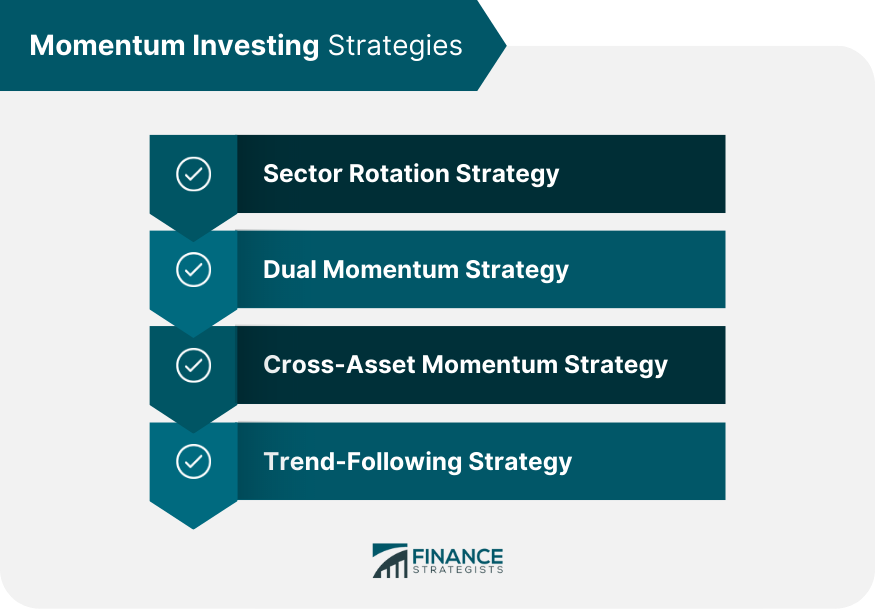Momentum investing is an investment strategy that seeks to capitalize on the continuance of existing market trends by buying securities with strong recent performance and selling those with poor performance. This approach is based on the belief that assets that have performed well in the past are likely to continue doing so in the future, while underperforming assets may continue to struggle. The underlying premise of momentum investing is that market trends, once established, tend to persist due to factors such as investor psychology, herding behavior, and information dissemination. By identifying and investing in assets that exhibit strong price momentum, investors can generate higher returns than passive investment strategies. The benefits of momentum investing include the potential for outperformance, the ability to capitalize on market inefficiencies, and the opportunity to profit from market trends. However, this approach also has drawbacks, such as the risk of sudden trend reversals, higher trading costs, and increased volatility and drawdowns. Relative strength is a key concept in momentum investing, as it measures the price performance of an asset relative to its peers or the broader market. Investors can use relative strength rankings to identify assets with strong momentum and allocate capital accordingly. Moving averages are commonly used in momentum investing to identify trends and generate buy or sell signals. By analyzing the relationship between an asset's current price and its moving average, investors can determine whether the asset is in an uptrend or downtrend and make investment decisions accordingly. Price breakouts and trendlines are technical analysis tools used by momentum investors to identify potential entry and exit points for trades. Breakouts occur when an asset's price moves above a resistance level or below a support level, indicating a potential continuation or reversal of the current trend. Momentum investing strategies can be applied across various time horizons and holding periods, ranging from short-term (days to weeks), medium-term (weeks to months), and long-term (months to years). The choice of time horizon will depend on the investor's objectives, risk tolerance, and trading style. The sector rotation strategy involves moving capital between sectors of the economy based on their relative strength and market trends. This approach aims to capitalize on the cyclical nature of various industries and the tendency for certain sectors to outperform others during different stages of the economic cycle. Dual momentum investing combines the concepts of absolute momentum (performance of an asset relative to its own historical returns) and relative momentum (performance of an asset relative to other assets) to identify investment opportunities. This approach seeks to invest in assets that exhibit both strong absolute and relative performance, potentially leading to higher returns and reduced risk. Cross-asset momentum strategies involve investing in multiple asset classes (e.g., equities, bonds, commodities) based on their price momentum. By diversifying across various asset classes, investors can potentially reduce portfolio risk and enhance returns. Trend-following strategies aim to capitalize on established market trends by buying assets in uptrends and selling assets in downtrends. This approach typically involves the use of technical indicators, such as moving averages and trendlines, to identify trends and generate buy or sell signals. Market sentiment and investor psychology play a crucial role in the success of momentum investing strategies. Positive sentiment can drive asset prices higher, while negative sentiment can cause prices to fall. By understanding and assessing market sentiment, momentum investors can better anticipate trend continuations or reversals. Market liquidity and trading volume can impact the effectiveness of momentum investing strategies. High liquidity and trading volume can facilitate the execution of trades and reduce transaction costs. In contrast, low liquidity and trading volume can lead to increased trading costs and the risk of price slippage. Economic cycles and market regimes can influence the performance of momentum investing strategies. Momentum strategies tend to perform well during periods of economic expansion and strong market trends but may underperform during periods of economic contraction or range-bound markets. Investor risk appetite and behavior can also affect momentum returns. During periods of increased risk appetite, investors may be more inclined to pursue momentum strategies, driving up the prices of high-momentum assets. Conversely, during periods of risk aversion, momentum strategies may underperform as investors seek safety in more conservative investments. Momentum strategies have historically delivered strong returns and outperformed passive investment approaches across various markets and asset classes. However, the performance of momentum strategies can be cyclical and may be influenced by factors such as market sentiment, economic conditions, and investor risk appetite. Momentum investing strategies can potentially deliver attractive risk-adjusted returns by capitalizing on market trends and exploiting inefficiencies. However, these strategies may also be subject to increased volatility and drawdowns, particularly during periods of market stress or sudden trend reversals. Momentum investing strategies can experience significant drawdowns during periods of market turbulence or trend reversals. Investors must be prepared for these drawdowns and have a plan in place for managing portfolio risk and recovering from losses. Momentum investing strategies can provide diversification benefits when combined with other investment approaches, such as quality and value investing. By allocating capital across various investment strategies, investors can potentially enhance portfolio returns and reduce overall risk. Momentum investing can be combined with other investment factors, such as value, quality, and size, to create a more diversified and potentially robust investment portfolio. By allocating capital across various investment factors, investors can benefit from each approach's unique return drivers and risk characteristics. Investors can implement momentum investing strategies using either active or passive approaches. Active momentum investing typically involves the use of discretionary trading strategies and security selection. In contrast, passive momentum investing relies on systematic rules-based strategies, such as those employed by index funds and exchange-traded funds (ETFs). Momentum investing strategies can be applied across various asset classes (e.g., equities, bonds, commodities)and geographies (e.g., developed markets, emerging markets) to enhance portfolio diversification and reduce risk. Momentum-focused ETFs and mutual funds offer investors a convenient and cost-effective way to gain exposure to momentum investing strategies. These funds typically invest in a diversified portfolio of assets that exhibit strong price momentum, with the aim of outperforming the broader market or a specified benchmark. Several popular momentum funds are available in the market, including those that focus on specific sectors, regions, or investment factors. Examples of such funds include the iShares Edge MSCI USA Momentum Factor ETF (MTUM) and the AQR Large Cap Momentum Style Fund (AMOMX). Investors should consider factors such as the fund's investment strategy, historical performance, risk-adjusted returns, fees and expenses, and portfolio management team when selecting momentum funds. Additionally, it is important to conduct due diligence on the fund's underlying holdings, sector exposures, and geographic diversification to ensure alignment with the investor's objectives and risk tolerance. Stop-loss orders and other risk management techniques can help momentum investors protect their portfolios from sudden trend reversals and large losses. By setting stop-loss orders at predetermined price levels, investors can limit their downside risk and exit positions when the market moves against them. Regular portfolio rebalancing and monitoring are essential for effective risk management in momentum investing. By periodically reviewing and adjusting their asset allocation, momentum investors can ensure their portfolios remain aligned with their investment objectives and risk tolerance. Momentum investors should continually assess market conditions and sentiment to identify potential trend reversals or shifts in investor behavior. By staying informed about market trends and economic developments, investors can better anticipate changes in market dynamics and adjust their momentum strategies accordingly. Investor psychology plays a significant role in the success of momentum investing strategies. Behavioral biases, such as herding behavior and overconfidence, can contribute to the persistence of market trends and the effectiveness of momentum investing strategies. Herding behavior occurs when investors follow the actions of others rather than making independent investment decisions. This can lead to the formation and persistence of market trends, as investors buy assets with strong recent performance and sell those with poor performance. Conversely, overconfidence can cause investors to underestimate the likelihood of trend reversals and the risk of large losses in momentum strategies. Confirmation bias refers to the tendency of investors to seek out and pay attention to information that supports their existing beliefs while ignoring contradictory information. This can lead to the persistence of market trends as investors continue to buy assets with strong momentum, believing their positive performance will continue. Availability bias occurs when investors place greater importance on readily available information, which can contribute to the formation and persistence of market trends. Momentum investing can play a valuable role in portfolio diversification by providing exposure to unique return drivers and risk characteristics. By combining momentum strategies with other investment approaches, investors can potentially enhance portfolio returns and reduce overall risk. Momentum investing may only be suitable for some investors, as it involves higher trading costs, increased volatility, and the potential for large drawdowns. Investors should carefully consider their investment objectives, risk tolerance, and trading style before incorporating momentum investing strategies into their portfolios.What Is Momentum Investing?
Key Concepts in Momentum Investing
Relative Strength
Moving Averages
Price Breakouts and Trendlines
Time Horizons and Holding Periods

Momentum Investing Strategies
Sector Rotation Strategy
Dual Momentum Strategy
Cross-Asset Momentum Strategy
Trend-Following Strategy

Factors Influencing Momentum Returns
Market Sentiment and Psychology
Market Liquidity and Trading Volume
Economic Cycles and Market Regimes
Risk Appetite and Investor Behavior
Performance and Risk Characteristics of Momentum Investing
Historical Performance of Momentum Strategies
Risk-Adjusted Returns
Drawdowns and Recovery Periods
Diversification Benefits
Incorporating Momentum Investing in Portfolio Construction
Combining Momentum With Other Investment Factors
Active vs. Passive Momentum Investing
Diversification Across Asset Classes and Geographies
Momentum Investing in Exchange-Traded Funds (ETFs) and Mutual Funds
Overview of Momentum Funds
Popular Momentum Funds
Selection Criteria and Due Diligence
Managing Risks in Momentum Investing
Stop-Loss Orders and Risk Management Techniques
Portfolio Rebalancing and Monitoring
Evaluating Market Conditions and Sentiment
Behavioral Finance and Momentum Investing
The Role of Investor Psychology
Herding Behavior and Overconfidence
Confirmation Bias and Availability Bias
Conclusion
Momentum Investing FAQs
Momentum investing is a strategy that involves buying stocks that have shown strong positive performance in the recent past and selling stocks that have shown weak negative performance.
Momentum investing works by identifying stocks that have exhibited strong price trends and buying them in the hope that the trend will continue. This is based on the belief that stocks that have performed well in the past are more likely to continue to perform well in the future.
The benefits of momentum investing include the potential for high returns and the ability to diversify a portfolio and reduce risk.
The risks associated with momentum investing include the potential for market volatility and the possibility that the trend will reverse and the stock will underperform.
No, momentum investing is not suitable for all investors. It is a high-risk strategy that requires significant research and analysis and should only be pursued by experienced investors who are comfortable with the associated risks.
True Tamplin is a published author, public speaker, CEO of UpDigital, and founder of Finance Strategists.
True is a Certified Educator in Personal Finance (CEPF®), author of The Handy Financial Ratios Guide, a member of the Society for Advancing Business Editing and Writing, contributes to his financial education site, Finance Strategists, and has spoken to various financial communities such as the CFA Institute, as well as university students like his Alma mater, Biola University, where he received a bachelor of science in business and data analytics.
To learn more about True, visit his personal website or view his author profiles on Amazon, Nasdaq and Forbes.











